In The Industry:
Theatre companies don’t usually hire makeup artists for shows unless it requires particularly heavy makeup. I know this because I have seen lots of videos online where people in shows doing their own makeup; some examples of this being ballerinas doing their own makeup for “The Nutcracker”, the credits of “Hamilton” on Disney+ not listing a makeup and even the actors in different performances of “Cabaret” doing their own 1930’s style makeup. This is because performers are often taught how to do their own makeup during rehearsals. However, for shows like “Shrek: The Musical” makeup artists are hired because of the heavy body paint and prosthetic application. Even though makeup artists are not needed a lot of the time in theatre, there are always people working on and applying wigs where needed.


I researched into the salaries of theatre makeup artists and according to this website, Makeup Artist, Theatrical and Performance Hourly Pay in United Kingdom in 2025 | PayScale , the average pay for a theatre makeup artist is £12.75 per hour in the UK. I also looked into the website Makeup Artist Salary in 2024: Salary Trends (and Job Description) For – hollywood mirrors again because it had descriptions of wages of lots of different parts of the industry, it said “Theatre makeup artists often work on a freelance or project basis. The average salary range can be around £20,000 to £35,000 per year, with experienced artists earning more. Pay rates may also vary depending on the size of the production, theater company, and location.” I thought that it was interesting that the location of a performance can impact the salary of the makeup artist because I didn’t know about that before this research.
Through the Hollywood Mirrors website, I also learnt about the skills that are required to succeed as a theatre makeup artist. These skills include adapting makeup to different lightings, interpreting different characters, communicating with directors/other makeup artists and skills in prosthetic application/ aging makeup/general theatre makeup. The responsibilities of a theatre makeup artist this website listed include collaboration and hygiene.
Case Study One: Costume Engineering
For my first case study I decided to look at costume engineering, specifically in the stage adaptation of The Lion King where the costumes are a key part of portraying the animals. I had previously seen this show in a theatre and I have a programme with details of the engineering behind this performance and the engineer herself, Julie Taymor:


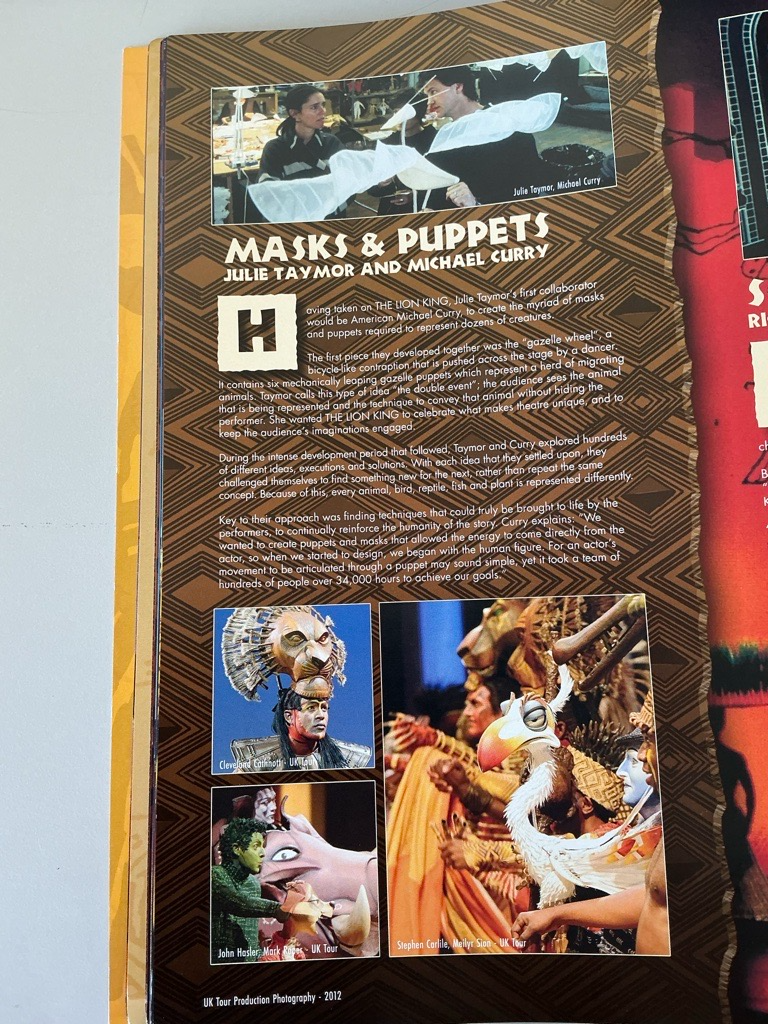
I have also visited the New York City Broadway Museum, where I took a picture of a costume from this show as well as a small prototype model of another costume that both demonstrate the important engineering that The Lion King relies on to properly portray the animals.
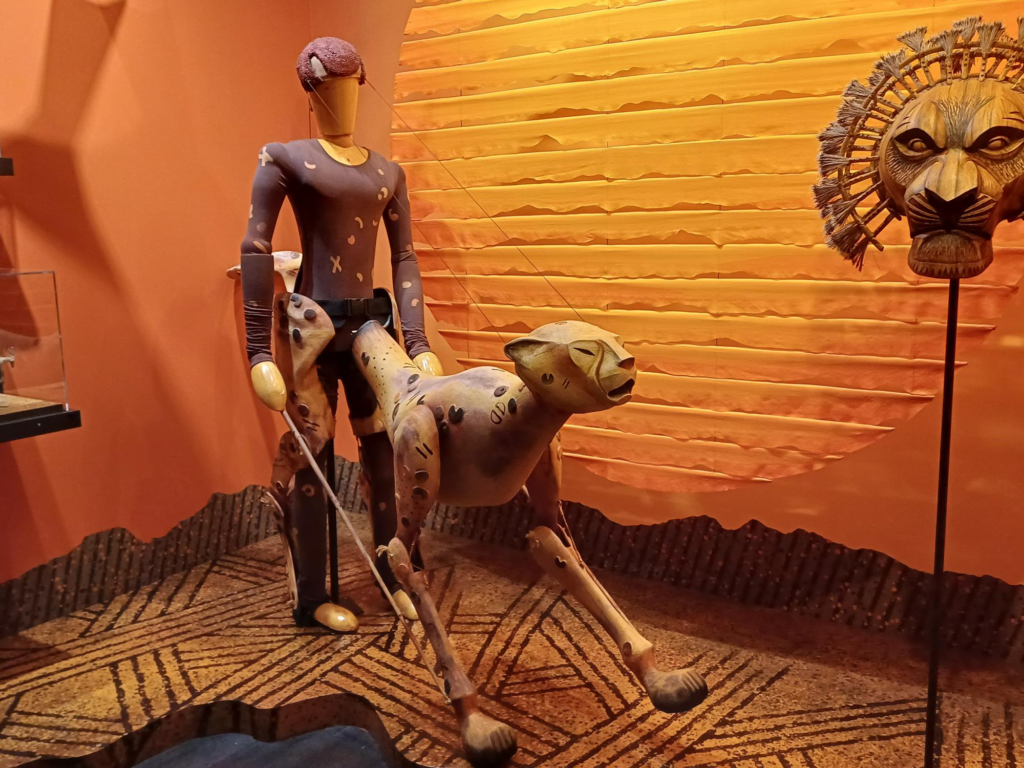
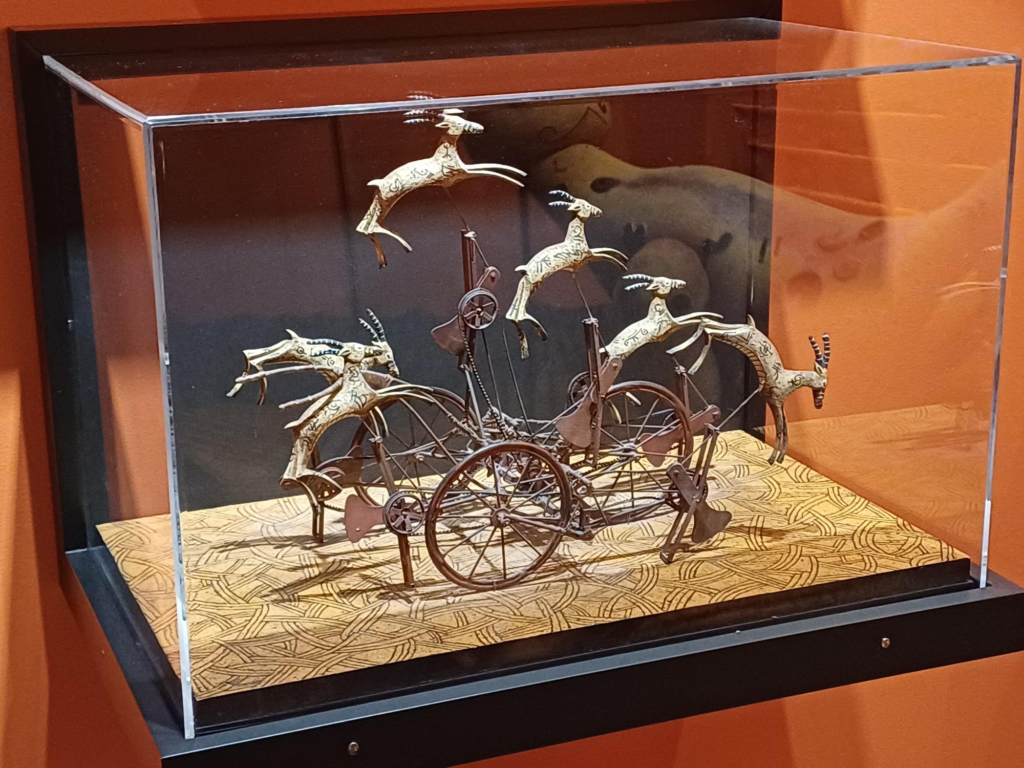
Having analysed these pages and images, I learnt that costume design in theatre is always very important for conveying messages, stories or for holding together a performance- whether that be simple costume elements that show parts of a character’s personality like in my own work, or in The Lion King where costume is an integral part of the entire show.
Case Study Two: The Use Of Colour And Culture
My second case study is also on the stage adaptation of The Lion King. Looking back through my programme, what I found interesting is how the makeup artist Michael Ward used cultural research and colours of nature (blues, browns and greens) for the actors. In my programme, you can read about how Ward used multiple different African cultures and linked them to different characters:

Here are some different examples of makeup being used to blend together the actor and the character they are playing/puppeteering:
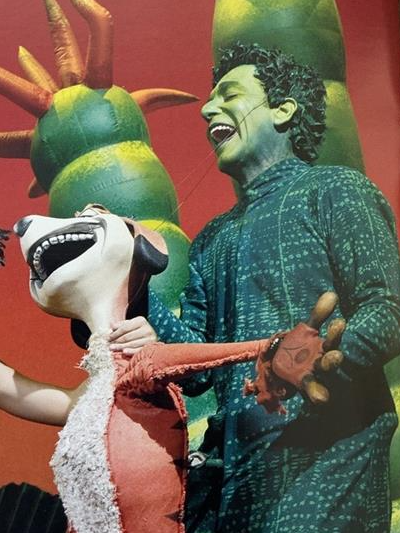


I particularly like the makeup and costume for Zazu because the entire look flowed well with the puppet, making the important yet difficult task of puppeteering while performing a lot easier; however all of the performer/ puppeteer looks flow well in my opinion. I think that The Lion King is one of the best and biggest influences in modern theatre, especially towards productions that do require more detail and expertise to make the show really work.
Case Study Three: Film Accuracy And Costume Development
My third case study is based on the stage adaptation of Chitty Chitty Bang Bang. I think that in creating an adaptation of a classic film it is important to keep the costumes accurate so as to keep the nostalgia of the original material. Here are some examples of some very good costume accuracy from the programme of the performance and screenshots from the original film I found on google images:
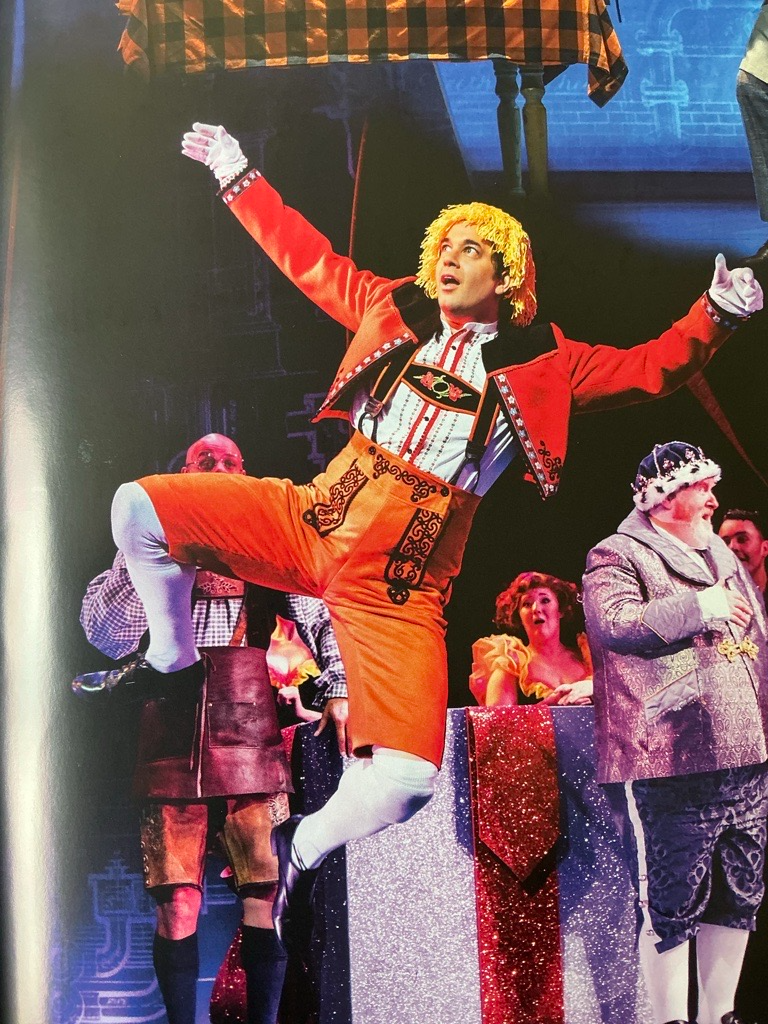

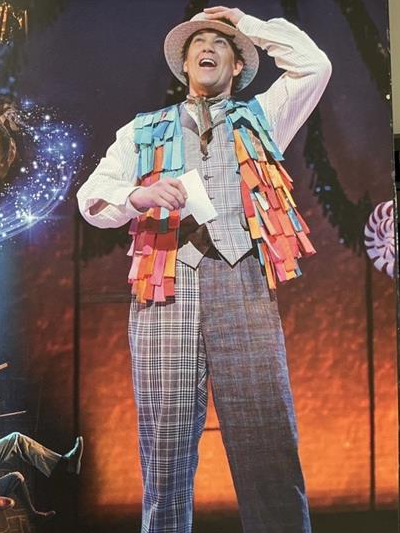

While these stage costumes are accurate in terms of design which I really liked when I saw Chitty Chitty Bang Bang in the theatre, it is also important to understand that costumes need to be adapted for the stage so that they work better. For example, the trousers in the top left image would have had to been adapted and tailored to be shorter because this scene had a lot more acrobatics in the choreography than the original film. It is also important to recognise that the theatre costumes cannot be completely accurate because film and theatre are very different pieces of media. When watching a film it is not live which makes it slightly less immersive whereas theatre productions have to be a lot more bold, vibrant and captivating because it is a live performance. This is the main reason why I think that the costumes in the scene portrayed in the bottom left image- particularly the waistcoat- have to be a lot more colourful. Chitty Chitty Bang Bang is also set in the 1910’s, which is another reason why the film’s costumes weren’t as colourful- the theatre performance was also set in the 1910’s but still needed to be more colourful for the reasons I have previously stated.
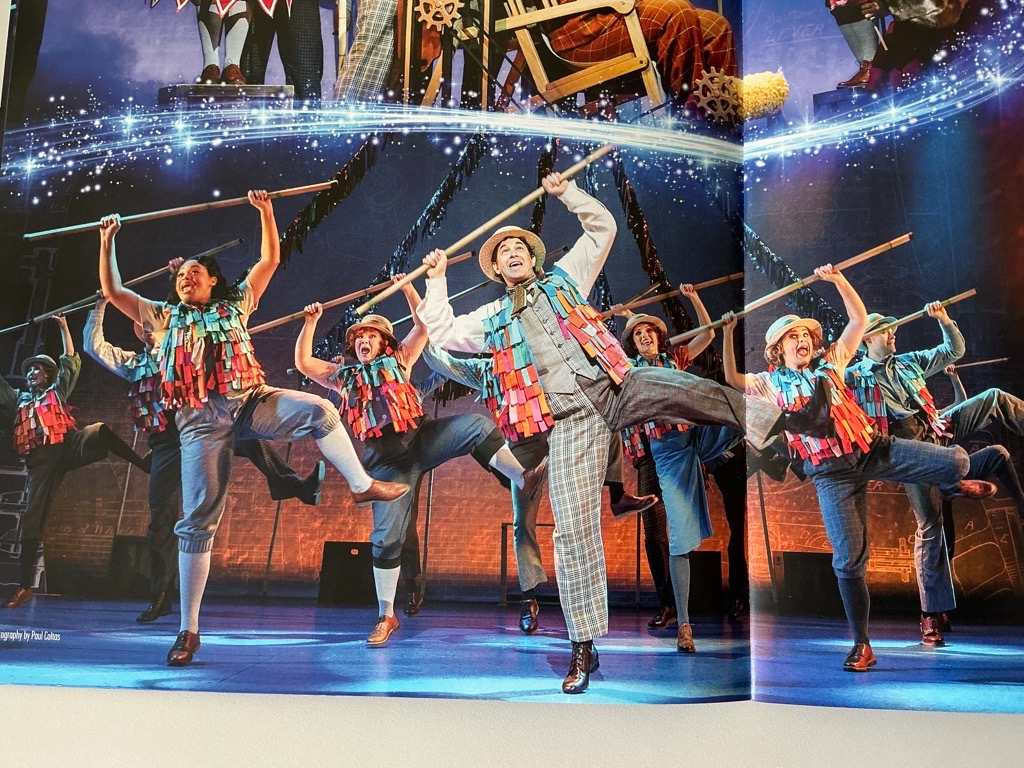
Case Study Four: 1930s makeup
My theatre makeup will be based on makeup worn in the 1920’s and 30’s because “Wicked” and it’s sequel “The Wizard Of Oz” are presumably set in a slightly earlier time frame. My other source of makeup inspiration comes from the musical “Cabaret”, which is set in the early 1930’s. The “roaring 1920’s” was the start of a particularly good era economically in between the first and second world war, especially in Europe. This era brought new makeup styles that included pale complections, thin eyebrows and a mix of bright and darker colours:


I think that makeup from this era was very theatrical and exaggerated, which is why I wanted to have a musical from this era (“Cabaret”) as part of my makeup inspiration as well as “Wicked”.
Research- Practices, Technique & Evaluation:
Throughout my final major project I created wigs for all three of my looks. In all three assessments it was very important for me to understand the kind of wig I was styling because of how it would react to different factors like heat. The different types of wigs I have seen from Google include human hair (lace front, full lace front and medical wigs that help with hair loss conditions), synthetic and heat resistant synthetic (cosplay wigs and doll hair).
From my own experience with wigs I have learnt about the very big difference between synthetic and heat resistant wigs. Synthetic wigs tend to be a lot shinier and stay that way even when washed, making them very difficult to style. Synthetic wigs are made of plastic so they will melt if intense heat is applied; this makes them even more difficult to style because you cannot manipulate the fibers enough for the wig to hold any style. For example, I once used a synthetic wig for an assessment and wanted to make it curly from being straight- I knew I couldn’t use hair curlers because the wig would melt but even when I put the wig into tight braids with lots of hairspray the wig was still pin straight. However with a heat resistant synthetic wig I was able to use heat products like curlers a lot more efficiently. I also found that heat resistant synthetic wigs are less shiny and a lot better in quality, these wigs also tend to hold the style quite well even when they have been brushed out depending on how much product was used/ how thoroughly the wig has been washed beforehand.
In my first practice, I couldn’t quite get the right consistency of face paint. I decided for my first practice to work with a regular foundation, concealer and contour base so that I could prioritise learning how to apply the eye makeup. I considered using a grease paint for the base instead, but my tutor advised against it because the powder products would mix with it and ruin the result:
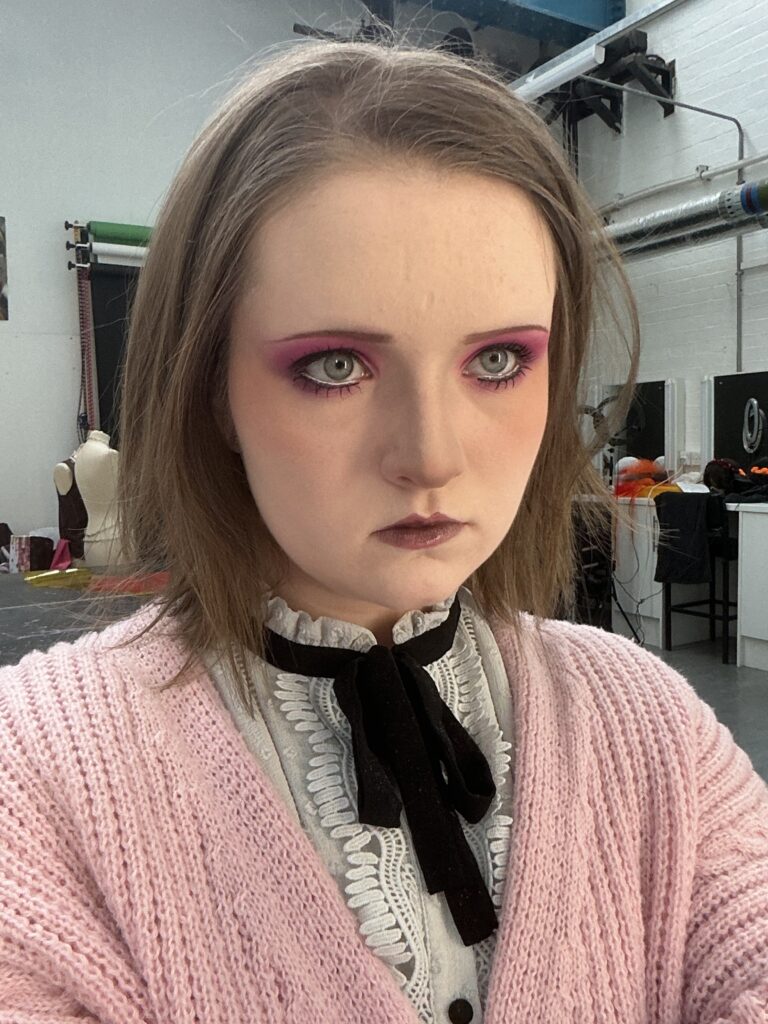
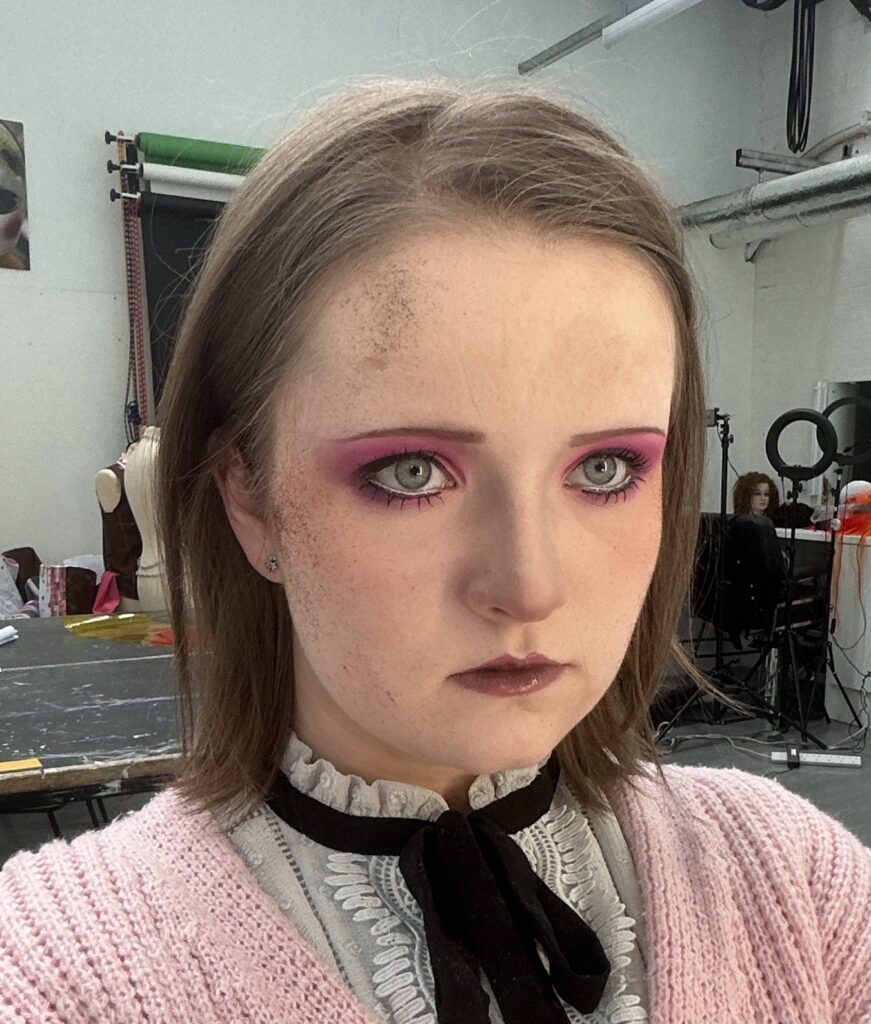
My tutors said that my look was good and that my brow framing was very nice. Both myself and my tutors agreed that I should try to have a lighter base to properly emphasise the theatrical aspect.
For my second practice I tried to create a mask like effect with my work, I found an extremely pale foundation and used that as a base. To create the mask effect I removed a ring of the foundation from the edges of my face and used a black face paint to create a border:
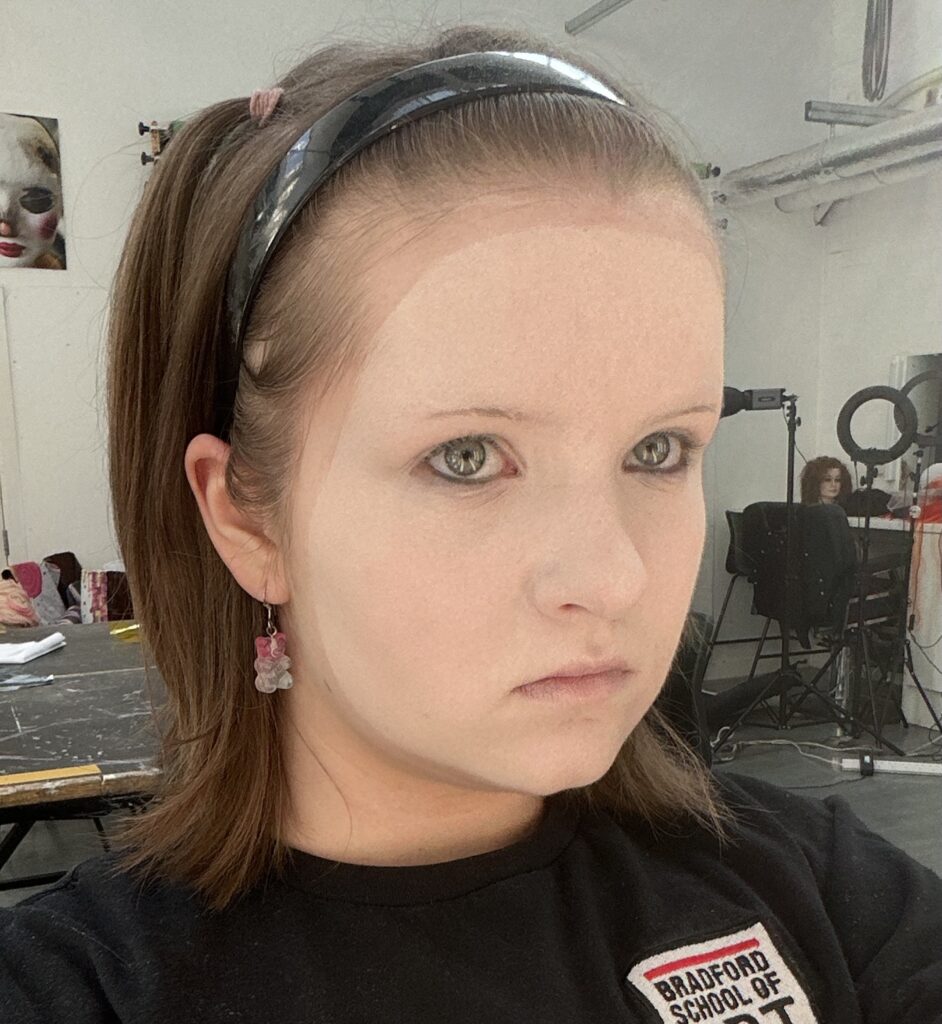
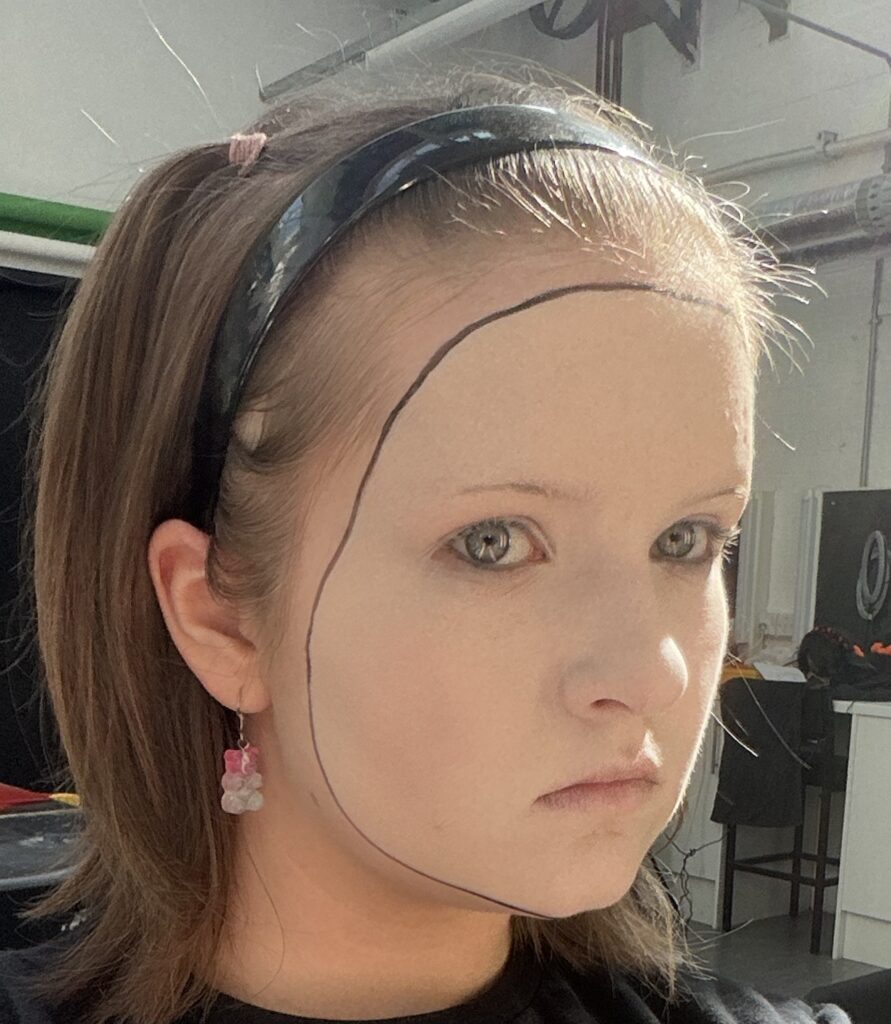
I realised after my assessment that I shouldn’t use this black liner because it is quite distracting. My tutor said that I should use shading to create the mask effect rather than a harsh black line.
I then used black and white eyeshadows to add nose contour. By using a light amount of black and white around the center of my face I can make the base makeup look white as opposed to cream:

I then mixed together some purple and black eyeshadow with some Vaseline to create a dark lip gloss. I applied this with a sharp angled brush. I also added an orange shade of blush to follow my face chart and 1930s makeup inspiration and added thin eyebrows:
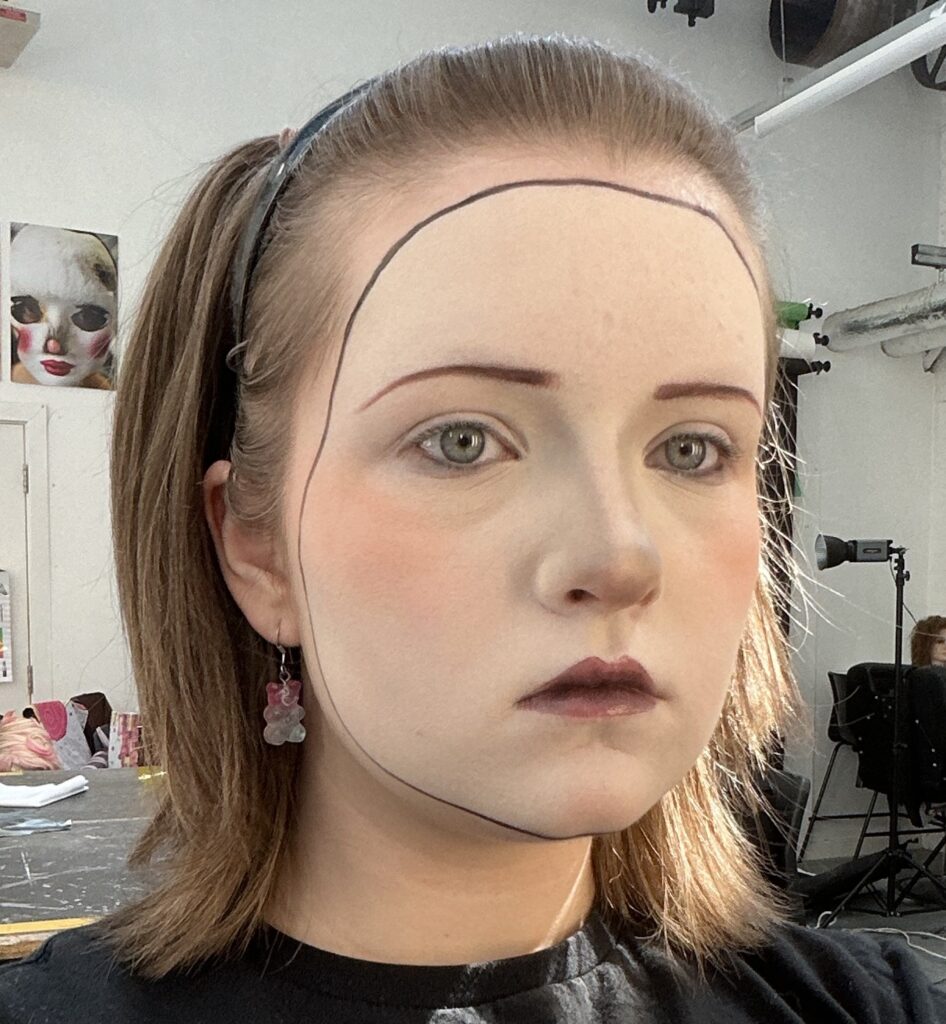
I then layered up purple and black eyeshadow around my eyes in a circular shape. As I was doing this practice one of my eyes became extremely irritated and watered a lot, for this reason I could only practice on one eye. Once my eyeshadow was applied I added exaggerated lower lashes using face paint, eyeliner and mascara. I also added dirt powder to complete this practice:
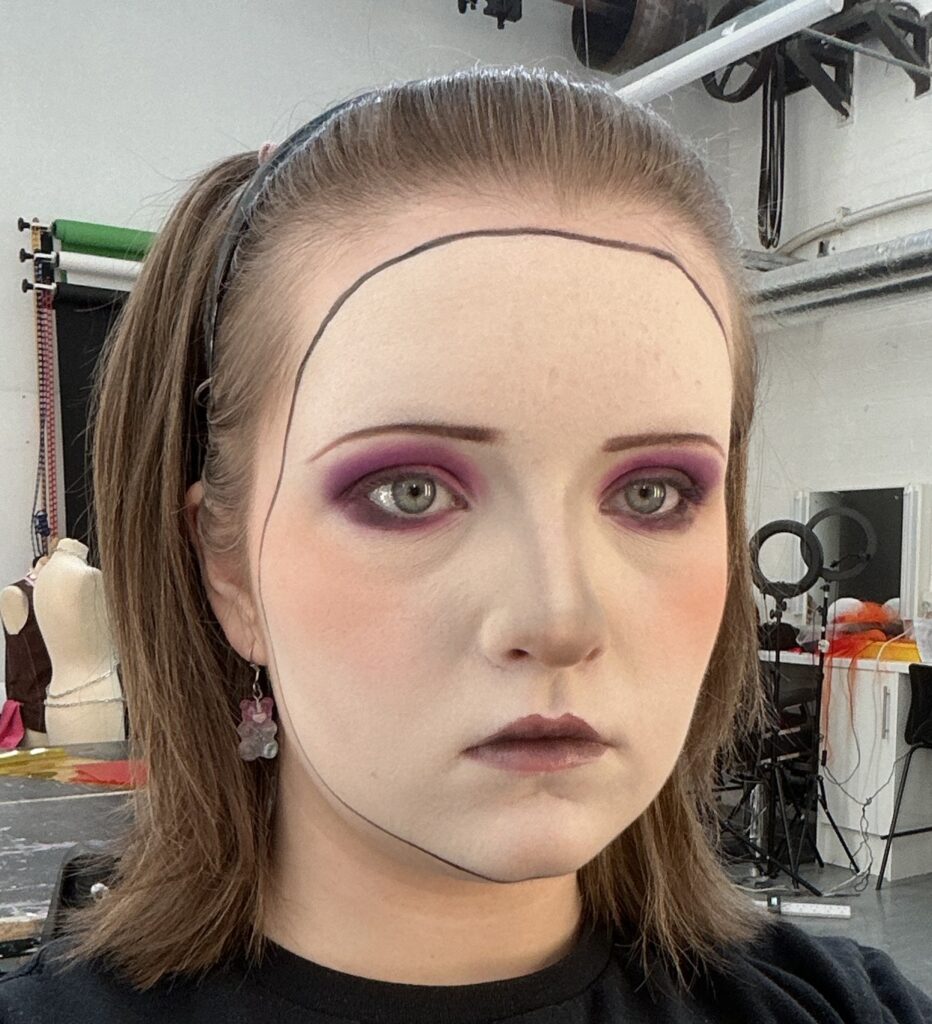
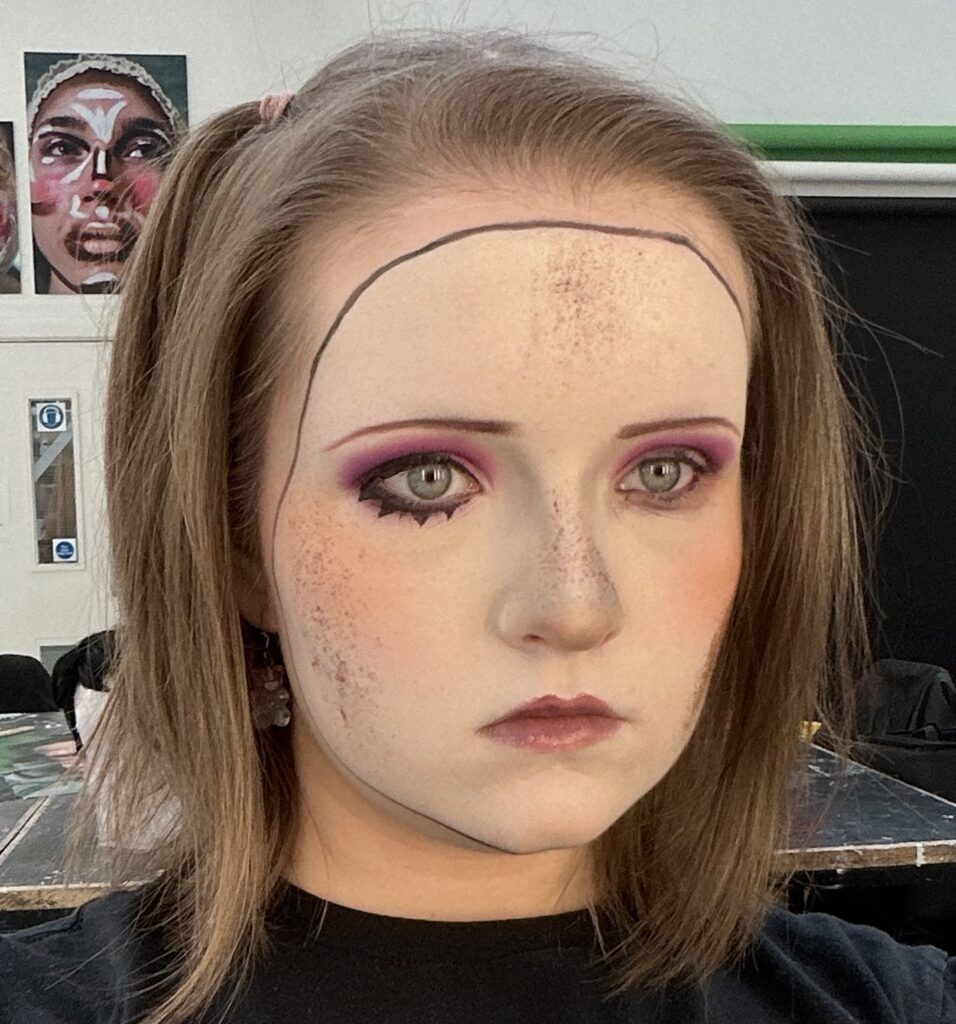
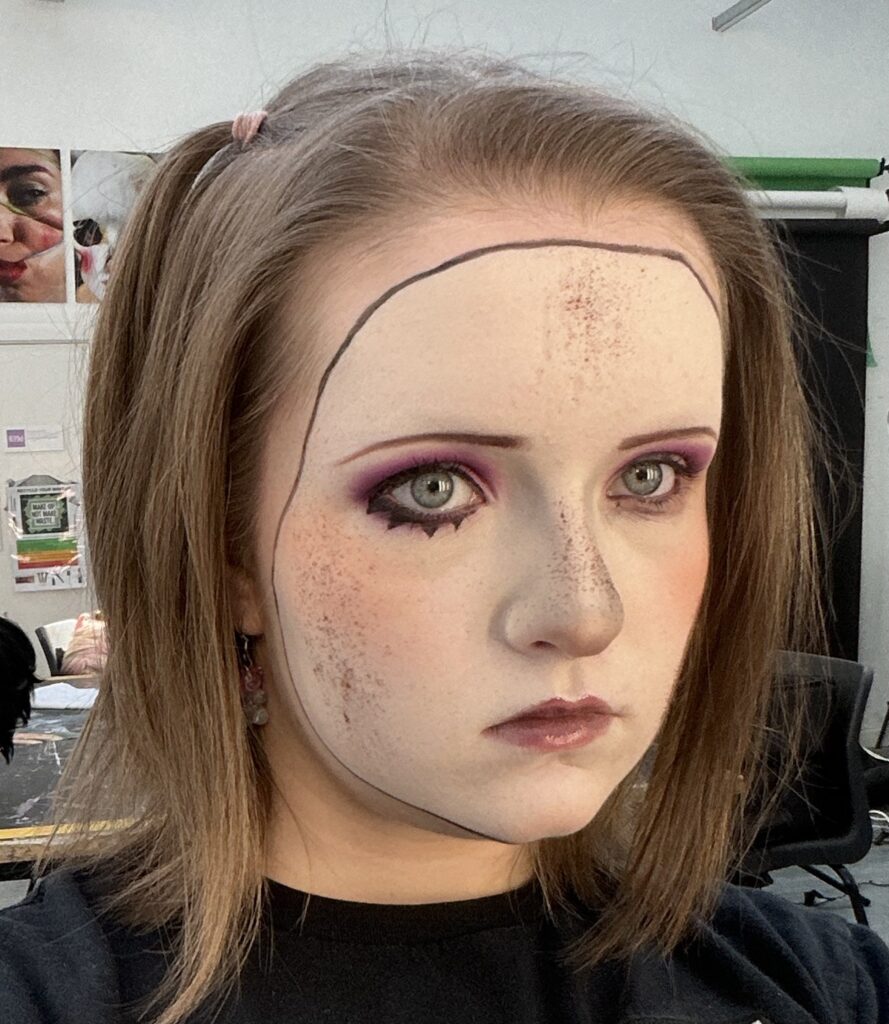
My tutor said that this practice was very good, I was advised to remove the black outline as well as make the eyelashes even more exaggerated because of the nature of theatre makeup. Theatre makeup is supposed to be able to be seen from far away as well as up close, which is something I was sure to take forward into my next practice:
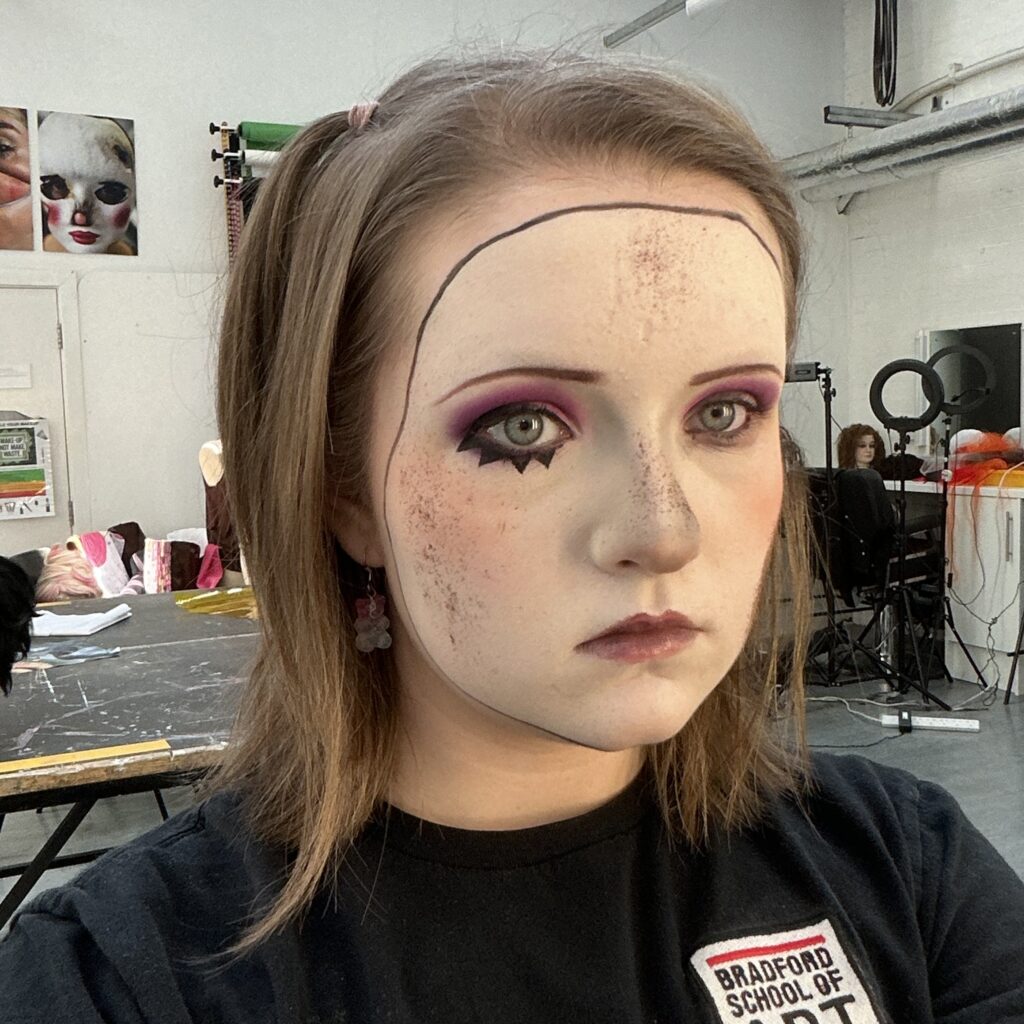
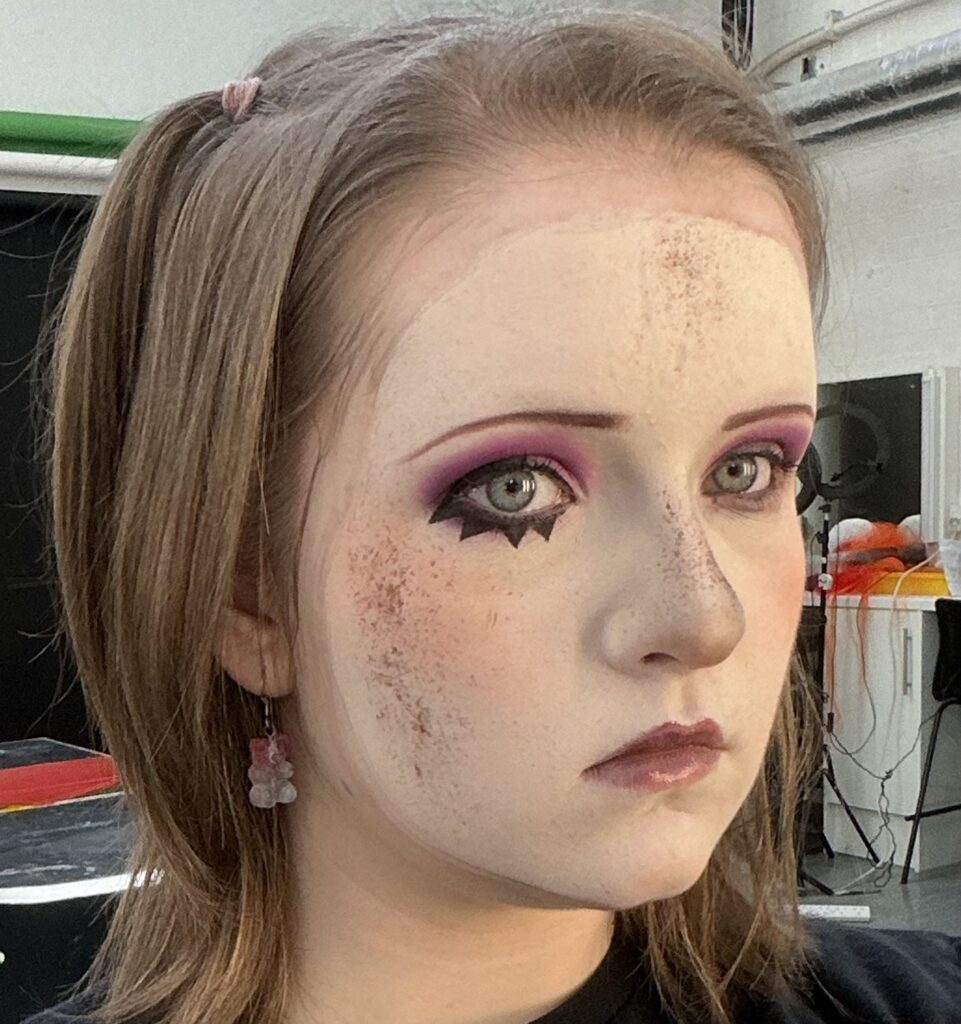
I thought that this looked a lot better without the black outline and I was very confident from this point that I would perform well in the last part of my final major project.
For my third practice, I followed the same steps as I did before but I practiced on both eyes and kept the plain edge around the face:

My tutor advised me to try a lip liner underneath the vaseline eyeshadow mix so that the colour would be bolder. I tried this with two different lip liners, one with purple undertones and one with red undertones, I tried this at the same time with the products on either half of my lip so that I could compare them both:
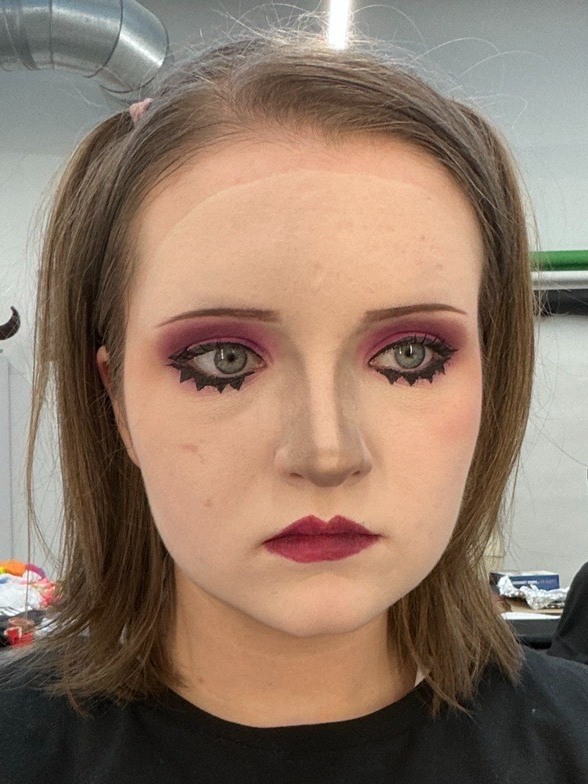
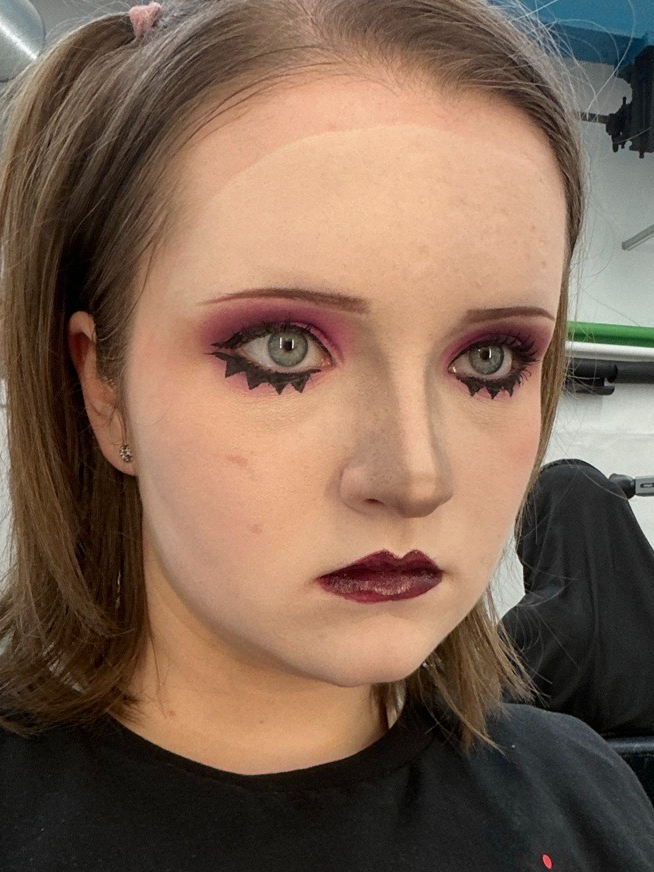
I liked the lip liner with the purple undertones (the right side of the images) because it had the right colour to complement the eyes, although I did end up changing my technique during my assessment.
Prices:
| Apron Fabric | £12 |
| Foundation | £6 |
| Buttons | £5 |